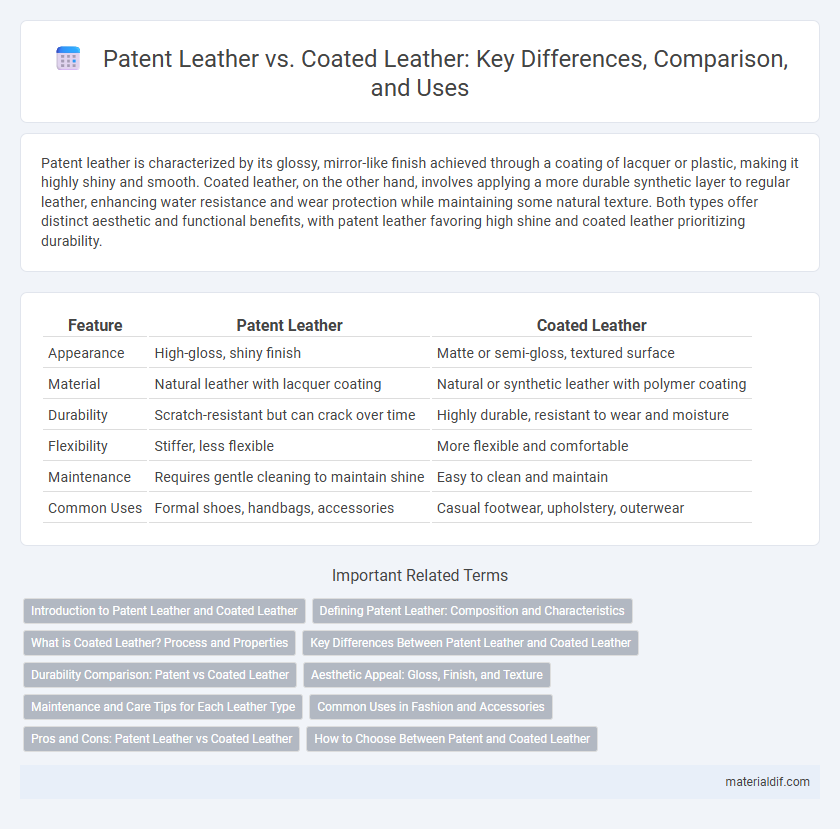Patent leather is characterized by its glossy, mirror-like finish achieved through a coating of lacquer or plastic, making it highly shiny and smooth. Coated leather, on the other hand, involves applying a more durable synthetic layer to regular leather, enhancing water resistance and wear protection while maintaining some natural texture. Both types offer distinct aesthetic and functional benefits, with patent leather favoring high shine and coated leather prioritizing durability.
Table of Comparison
| Feature | Patent Leather | Coated Leather |
|---|---|---|
| Appearance | High-gloss, shiny finish | Matte or semi-gloss, textured surface |
| Material | Natural leather with lacquer coating | Natural or synthetic leather with polymer coating |
| Durability | Scratch-resistant but can crack over time | Highly durable, resistant to wear and moisture |
| Flexibility | Stiffer, less flexible | More flexible and comfortable |
| Maintenance | Requires gentle cleaning to maintain shine | Easy to clean and maintain |
| Common Uses | Formal shoes, handbags, accessories | Casual footwear, upholstery, outerwear |
Introduction to Patent Leather and Coated Leather
Patent leather features a high-gloss finish achieved by applying a lacquer or varnish coating to the leather surface, creating a shiny and smooth appearance ideal for formal footwear and accessories. Coated leather, on the other hand, involves applying a durable synthetic layer, such as polyurethane, to enhance water resistance and durability while maintaining flexibility. Both types offer unique aesthetic and protective qualities, with patent leather emphasizing visual shine and coated leather focusing on practical performance.
Defining Patent Leather: Composition and Characteristics
Patent leather is a type of coated leather characterized by its glossy, mirror-like finish achieved through a lacquer or varnish coating on the surface. Its composition typically involves a base leather, such as cowhide, treated with polyurethane or acrylic resin to create a durable and water-resistant outer layer. This coating gives patent leather its distinctive shine and smooth texture, making it popular for formal footwear and fashion accessories.
What is Coated Leather? Process and Properties
Coated leather is natural leather treated with a polymer finish, such as polyurethane or acrylic, to enhance durability, water resistance, and appearance. The process involves applying multiple layers of coating on the leather surface, creating a smooth, glossy finish that mimics patent leather while offering increased scratch resistance. This treatment retains the flexibility and breathability of leather while providing a protective barrier against stains and environmental damage.
Key Differences Between Patent Leather and Coated Leather
Patent leather features a high-gloss, mirror-like finish achieved through a lacquer coating, making it more rigid and less breathable compared to coated leather. Coated leather, treated with a polyurethane or acrylic layer, offers enhanced durability and water resistance while maintaining greater flexibility and a more natural texture. The primary distinctions lie in appearance, finish durability, and flexibility, with patent leather favoring aesthetics and coated leather emphasizing practicality.
Durability Comparison: Patent vs Coated Leather
Patent leather features a glossy, high-shine finish achieved through a lacquer coating, which offers moderate water resistance but is prone to cracking and discoloration over time if not properly maintained. Coated leather incorporates a durable synthetic layer bonded to the leather surface, providing enhanced resistance to scratches, moisture, and UV rays, resulting in greater overall durability. For long-lasting use, coated leather generally outperforms patent leather due to its superior protective qualities and structural resilience.
Aesthetic Appeal: Gloss, Finish, and Texture
Patent leather features a high-gloss, mirror-like finish achieved through a lacquer coating, offering a sleek and polished aesthetic ideal for formal footwear and accessories. Coated leather, treated with polyurethane or acrylic layers, provides a versatile matte to semi-gloss finish with enhanced textural variation that mimics natural grain while maintaining durability. The choice between patent and coated leather balances the desire for striking shine against subtle texture and finish diversity suited for various fashion applications.
Maintenance and Care Tips for Each Leather Type
Patent leather requires gentle cleaning with a soft, damp cloth and occasional use of a patent leather conditioner to maintain its glossy finish and prevent cracking. Coated leather benefits from regular dusting and the application of a mild leather cleaner followed by a protective conditioner designed for synthetic coatings to preserve flexibility and appearance. Avoid excessive heat and direct sunlight for both types to prevent damage, and store in a cool, dry place to extend their lifespan.
Common Uses in Fashion and Accessories
Patent leather is widely used in fashion accessories such as shoes, handbags, and belts due to its glossy, reflective finish that adds a sleek, formal look. Coated leather, featuring a durable synthetic layer, is commonly found in casual footwear, backpacks, and outerwear, offering water resistance and enhanced durability. Both materials cater to distinct style needs, with patent leather emphasizing polished elegance and coated leather prioritizing practicality and weather protection.
Pros and Cons: Patent Leather vs Coated Leather
Patent leather offers a high-gloss, mirror-like finish that is highly durable and water-resistant, making it ideal for formal footwear and accessories, but it can crease easily and may crack over time with improper care. Coated leather, coated with a thin layer of polyurethane or plastic, provides enhanced water resistance and a matte or semi-gloss finish with greater flexibility and scratch resistance, but it can wear down or peel with extensive use. Both leathers require specific maintenance to preserve appearance, with patent leather demanding gentle cleaning to avoid dulling the shine and coated leather benefiting from regular conditioning to prevent surface degradation.
How to Choose Between Patent and Coated Leather
Choosing between patent leather and coated leather depends on the desired finish, durability, and use case. Patent leather offers a high-gloss, reflective surface ideal for formal footwear and accessories, while coated leather provides a more matte or textured finish with added water resistance and flexibility. Consider the specific application, maintenance requirements, and aesthetic preferences to select the best option for your leather goods.
Patent Leather vs Coated Leather Infographic

 materialdif.com
materialdif.com